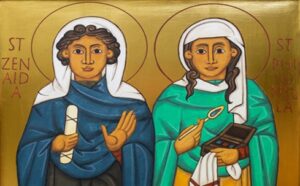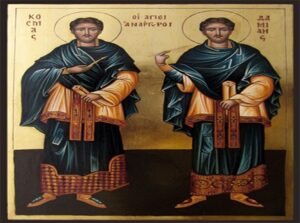Dimosthenis Papadimitrakis1, Miltiadis Perdikakis1, Gregory Tsoucalas2, Dimitrios Filippou1,3
1 School of Medicine, National and Kapodistrian University of Athens, Athens, Greece
2 Dept. of the History of Medicine and Deontology of Medicine, School of Medicine, University of Crete, Heraklion, Greece
3 Research and Education Institute in Biomedical Sciences
Corresponding Address: Dimosthenis Papadimitrakis, National and Kapodistrian University of Athens School of Medicine, Athens, GRC, dipapadimitrakis@gmail.com
Introduction
Introduction. In the history of Christianity, there have been many saints with the status of physician, of various specialties. The Orthodox Christian teaching and church applaud the progress of science and especially medicine. Medicine is a work of blessing since it ensures the eudoxification of health. The Orthodox Church rejoices in scientific progress, discoveries, new medicines and modern achievements of medical practice. This synergy is confirmed both by the sacred texts of the Holy Bible and by the very act of the Church over the centuries.
Luke the Evangelist. Luke was a physician from the Hellenistic city of Antioch in Ancient Syria (Figure 1). It is not certain whether he was Greek or a Hellenic Jew. Regardless of his ethnicity, Luke is recognized for his high level of education, demonstrated by his proficient Greek and references to classical Greek authors. This education likely stemmed from the Hellenistic curriculum of his youth. Luke is traditionally identified as the author of the Gospel of Luke and the Acts of the Apostles. Luke’s Gospel includes several detailed accounts of healings, such as the healing of the hemorrhaging woman (Luke 8:43-48) and the man with dropsy (Luke 14:1-6). These accounts often use precise medical terminology, which may reflect Luke’s medical training. His attention to detail and structured narrative style in both the Gospel and Acts indicate a methodical and analytical approach, consistent with someone trained in the medical sciences. Luke was present with Paul in Rome and is also thought to have contributed to the Epistle to the Hebrews. He died at age 84 in Boeotia (1).
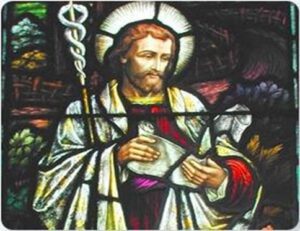 |
Figure 1: St. Luke, Evangelist and Physician. |
Zenaida and Philonella. Zenaida and Philonella were sisters born in a rich Jewish family in the city of Tarsus (Figure 2). They were instructed and baptized into the Christian faith by their brother Jason, who was bishop of Tarsus. They studied medicine and practiced their profession unprofitably while at the same time preaching the Gospel. The result of their work was the conversion of many people to Christianity. They relocated to the mountainous region around Pelion near Demetriada in Thessaly, an area famous for its healing springs and shrines to Asclepius. The local physicians served wealthy clients, charging high fees and increasing their income by selling magical amulets and charms. The sisters, however, opposed this common practice. They found a cave with a mineral spring, where they set up a chapel and living quarters, and opened a clinic to treat all patients regardless of their financial means. Philonella focused on experimental medicine, using methods similar to modern scientific practices, and worked diligently to separate effective treatments from superstitions. Zenaida was especially interested in pediatrics and later dedicated herself to the treatment of psychiatric disorders, such as clinical depression. Both sisters committed themselves to prayer when not working in their clinic. Their death was either peaceful or a result of an attack by pagans (2).
Figure 2: Saints Zenaida and Philonella by Symeon van Donkelaar |
Antipas of Pergamum. Antipas of Pergamum lived during the 1st century A.D. He studied at the famous medical school of Pergamum and practiced medical science uncharitably, specializing in treating pain and dental diseases. According to Christian tradition, John the Apostle ordained Antipas as bishop of the Church of Pergamon during the reign of the Roman emperor Nero. During his time, Pergamum was a pagan city with a famous Asklepion. The Christian population was just a minority in the city and persecutions against Christians were the common practice. In one of those, Antipas was arrested and led to the local ruler. After rejecting the offer to spare his life and staying loyal to his Christian faith he was sentenced to death and martyred in the Brazen Bull. In this, the condemned were locked inside the device (with their head aligned within the bull’s head), and a fire was set beneath it, heating the metal to the extent that the person within was slowly roasted to death. His fame made him the patron saint of the dentists and contributed to the construction of the Byzantine church of Saint Antipas in the precinct of the Dental School of Athens in Goudi which was inaugurated on May 25, 1975 (3).
Hermione of Ephesus. Hermione came from Caesarea of Palestine and studied medicine and philosophy. She was one of the four daughters of Saint Philip the Evangelist, practiced medicine uncharitably, and was a deeply faithful Christian. Hermione and her sister Eukhilda traveled to Ephesus to meet John the Evangelist in order to help him with his missionary work. Despite not finding him due to his death they decided to stay in Ephesus. Hermione founded there the first Christian hospital in Ephesus where she treated all people in need of medical care. The sisters were arrested and tortured by order of the emperor Trajan but were eventually set free. However, when Hadrian ascended the throne of emperor, Hermione was captured, tortured, and finally beheaded, becoming a martyr of the Christian faith (4).
Diomedes of Tarsus. Diomedes was born in Tarsus during the 3rd century A.D. and studied medicine. He traveled across the world and practiced medicine uncharitably while preaching the Gospel to the sick, converting many of them to Christianity. During the Great prosecution of Diocletian, Diomedes arrived at Nicaea to help the sick and preach. There the emperor ordered his arrest sentencing him to death. However, he died before his arrest. Despite his death he was beheaded by Roman soldiers (5).
Blaise of Sebastea. Blaise of Sebastea (Saint Blaise) was born in the early 4th century A.D. in the city of Sebastea in Armenia. After studying philosophy and medicine he returned to his city of birth to practice medicine. At the same time, Blaise preached the Christian faith and converted thousands of pagans to Christianity. When the bishop of the city died, he was chosen to succeed him thus becoming bishop of the Church of Sebastea. After some time, he retired to Mount Erciyes where he remained as a prayer. There, he gathered herbs and minerals from which he prepared medicines that he distributed free of charge to anyone in need. In 316, Agricola, the governor of Cappadocia and of Lesser Armenia, arrived in Sebastia at the order of the emperor Licinius to persecute Christians. Blaise was arrested and after denying to denounce his faith he was tortured and beheaded. References of Blaise can be traced in the writings of Aetius Amidinus where his practice of treating patients with throat infections is presented. He is considered the patron of otorhinolaryngology (6).
Thalalaios the physician from Lebanon. Thalalaios a diligent, and faithful Christian, he had studied at many schools, but finally devoted himself to medical science. Being a physician, fe did not receive any remuneration from the people he healed. The Orthodox Church calls him an Unmercenary Physician. He was beheaded during his martyrdom at Aegea, in the autumn of the year 284 (or 289) (7).
Pantaleon. Pantaleon lived during the 3rd century A.D and came from the city of Nicomedia in Anatolia (Figure 3). He received his medical training from the esteemed physician Euphrosinos. With Euphrosinos’s support, he was subsequently appointed Emperor Maximian’s physician. At the same time, he treated poor sick people without any charge for his medical services. During the Diocletian prosecution, Pantaleon was arrested. After refusing to denounce his faith Pantaleon was condemned to death and beheaded becoming a martyr of Christianity (8).
Cosmas and Damian. There are three pairs of saints named Cosmas and Damian. The first were brothers, who lived in the time when Carus was emperor of the Romans, they were physicians by profession and provided healing to all who were in need. In return, they did not take money but asked the patient to believe in Christ. They even cured emperor Carus himself of a wry neck, which resulted in enormous glory and fame for the brothers.
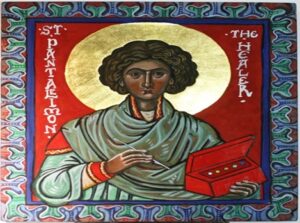
Figure 3: Hand-painted icon of St Panteleimon by Joan Burkitt-Gray.
Eventually, that fame led to their end as their former teacher was so jealous that he caused them to be stoned to death. The second pair named Cosmas and Damian (Figure 4), were twin brothers living in the Aegea of Cilicia. They studied medicine and surgery and became two of the most famous physicians in the known world. However, they refused all payment and practiced their work uncharitably. During Diocletian’s persecution, they were denounced for their Christian faith and arrested by Lycias of Arabia. After much torture, they suffered death by beheading. The third pair were famous doctors and veterinary surgeons. Their mother was Saint Theodoti, who nurtured them in Christian values and principles. They studied the Gospel and never accepted payment for their services. They died peacefully in their hometown (9)(10).
Figure 4: Cosmas and Damian the Saint Anargyroi. |
Saint Basil the Great. Saint Basil the Great (Basil of Caesarea) was born to a wealthy family around 330 A.D. in Cappadocia. His studies began in Caesarea, continued in Constantinople, and lastly in Athens where he stayed for four years to excel at philosophy, rhetoric, grammar, astronomy, and medicine. For approximately a year, he practiced law and taught rhetoric in Caesarea. Basil’s life underwent a profound transformation after meeting Eustathius of Sebaste, a charismatic bishop and ascetic. Renouncing his legal and teaching career, Basil dedicated his life to God. He traveled to Egypt, Palestine, Syria, and Mesopotamia to be taught about ascetic life and stayed as a monk in a monastery of Pontos for 5 years (357 – 362). In 370 A.D. he succeeded bishop Eusebius and was ordained as archbishop of Caesarea. Basil took the lead in the struggle against the heresy of Arianism and courageously defended the Orthodox Christian faith. His literary work is vast and important, consisting of many discourses, six ascetic writings, two doctrinal writings, and 365 letters. Furthermore, he constructed an extensive complex just outside Caesarea, known as the Basiliad, which comprised a poorhouse, hospice, 300-bed hospital, wards for travelers who were sick, and a unit for people with leprosy which became a lasting monument of Basil’s episcopal care for the sick and the poor. Basiliad was the inaugural hospital established by the Christian church, marking the beginning of numerous such institutions constructed worldwide, both in ancient and modern eras. At the age of fifty, Basil the Great, dies due to an illness (some sources say from severe liver or kidney disease), on January 1, 378 AD. or according to others in 379 to 380 A.D., bequeathing to humanity a huge spiritual work and an outstanding paradigm (11) (12).
Gregory of Nyssa. Gregory was born in Neocaesarea of Pontus in 332 A.D. and he was the brother of Basil the Great. Little is known of what further education he received. Some say that he accompanied his brother, Basil, in Athens while others argue that he studied classical literature, philosophy, and perhaps medicine in Caesarea. Gregory became bishop of Nyssa and had a major role in the First Council of Constantinople. He is known for his theological and philosophical work rather than his work as a physician. However, his works occasionally touch on themes related to health, the human body, and healing, reflecting the broader context of early Christian engagement with medicine. In On the “Making of Man”, Gregory reflects on the creation and nature of the human body. While this is a theological work, it demonstrates an understanding of human anatomy and physiology, influenced by the medical knowledge of his time. Gregory discusses the harmony and functionality of the body, seeing it as a reflection of divine wisdom. Gregory draws on both earlier sources such as Galen and contemporary sources. He produced detailed descriptions of the human body’s functions and acknowledged the ability of humans to learn from sensory experience. According to Gregory, the human body consists of three groups of organs: i. The vital organs that are necessary for life to exist i.e. brain, heart, liver, ii. The sensory organs and iii. The reproductive organs. Other organs such as the stomach and lungs only serve to support the three systems mentioned above. Furthermore, he explains how the elements of the material world interact and are used by the body. He describes the body as a perfect balance of heat and cold, as well as moisture and dryness. He accurately describes the role of the heart, the lungs, the liver, and the stomach in the function of the human organism. Regarding the brain, Gregory acknowledges its importance, characterizing it as the seat of the mind. He observed the proximity of the eyes, ears, nose, and mouth to the brain to directly transmit information from the senses to the brain while also observing that the nerves connect to the brain via the spinal cord, enabling sensory input from the extremities to reach the brain. Additionally, the immediate onset of death following a brain injury provides further evidence that the brain is the seat of the mind. He died around the year 395 A.D. (13).
Sampson the Hospitable. Sampson was born and raised in Rome to a rich family thus studying philosophy and medicine. As a physician, Sampson never sought the pecuniary benefits and treated all patients lovingly and without discrimination. When his parents died, he gave away his inherited fortune and moved to Constantinople. There, he visited all the monasteries where he found peace and studied the Gospel. He turned his house into a free clinic where patients were provided all the necessary medical care and food. He even treated Justinian, the Byzantine Emperor, when he fell ill. For Justinian to express his appreciation and gratitude to Sampson, Justinian built a hospital in Constantinople that quickly became a great charitable institution where the needy and the weak took refuge to be healed and find comfort and support for 600 years. Sampson died circa 530 A.D. (14).
Zenobius, the wealthy physician from Cilicia. Saint Zenovius Bishop of Cilicia, studied medicine, healed and worked miracles in his area. He was the heir to a large fortune, but this did not prevent him from distributing it to the poor. The holy physician healed without money. He was beheaded together with his sister Zenobia by the prefect Lysias (15).
Agapetus of the Kiev Caves. Agapetus was born during the 11th century A.D. in Kiev. He lived as a monk in the Kiev Monastery of Caves where he practiced medicine. There, he treated not only his monastic brethren but also many laymen who asked for his help. He used to collect herbs which he later boiled and administered to his patients as a drug to recover from their disease. Those oiled herbs were once used to treat Prince Vladimir Monomakh of Chernigov, the future Great Prince of Kiev himself. Saint Agapetus died in 1095 due to sickness (16).
Luke of Simferopol. Luke (Valentine Felixovich Voino Yassenetski) (Figure 5) was born in Kertz, on April 27th, 1877. He studied Medicine at the Great Prince St. Vladimir Medical School at the University of Kiev between 1898-1903. After graduating Luke specialized in surgery and ophthalmology at the University of Kiev. During the Russian-Japanese War he served at the Red Cross Hospital in Chita, where he gained significant surgical experience, particularly in major skeletal and cranial surgeries. Concurrently, he focused on treating pyogenic infections, a major issue in daily medical and surgical practice. For thirteen years, he worked extensively in this area as a provincial doctor in Siberia and other regions (Simbirsk, Kursk, Saratov). Luke has also been extensively involved in research in the field of regional anesthesia making the first recorded attempt to treat trigeminal neuralgia. In 1917 he was appointed as the head surgeon of the Tashkent Municipal Hospital, while in 1921 he was appointed professor of Topographic Anatomy and Surgery at Tashkent’s University. At the same year, he was ordained priest by Bishop Innokenty of Tashkent. In 1923 an era of intense persecution of Orthodox Christians in Russia began, which saw the execution of numerous clergy and monks. Bishop Innokenty of Tashkent was sent into exile, thus Luke was appointed as his successor in May 1923. In December 1923, Bishop Luke himself was exiled for the first of three times, enduring a total of 11 years in exile without formal charges. His initial exile took him to Omsk, followed by Novosibirsk and Krasnoyarsk in central Siberia, before being relocated 430 kilometers north to Yeniseisk. During his exile, Bishop Luke transformed his prison into a chapel and outpatient clinic. In 1924, he achieved a medical milestone by performing the world’s first successful kidney transplantation from an animal to a human. He also conducted various surgeries, including ophthalmological, gynecological, pediatric, and neurosurgical operations. Bishop Luke continuously treated outpatients both in the hospital and at his prison, and taught new surgical techniques to his peers and young doctors, who respected and admired him greatly. Later, he was moved to the remote village of Khaya on the Chunya River, where he continued to practice surgery despite minimal equipment. In the summer, he returned to Yeniseisk to operate at the hospital and serve in an old monastery. Due to his ecclesiastical activities, he was transferred to Turukhansk under harsh conditions. There, he performed surgeries with only a pocketknife. Bishop Luke’s preaching and spiritual support led to public outcry, prompting his return to Turukhansk, where he continued his medical work with dedication. Eventually, he was permitted to settle in Krasnoyarsk, where he immediately resumed his surgical practice. He performed a range of procedures, including iridectomies, lacrimal sac removals, upper jaw resections, large laparotomies, and gynecological operations, continuing to treat diverse medical conditions and injuries. In April 1930, he was arrested on charges of incitement to murder and underwent intense interrogation. He was transferred between several locations, including Samara, Moscow, Kotlas, and eventually Archangel, where he lived in near-homelessness but continued performing surgeries, including radical operations on breast cancer. Due to the harsh conditions of exile, Bishop Luke developed severe health issues. In late 1933 he was released but in 1937, he was arrested again during a severe persecution of the Orthodox Church and subjected to brutal treatment. Despite severe torture and a hunger strike, he maintained his faith and continued to help others. During World War II, after the German invasion in 1941, Bishop Luke served as a chief surgeon in Krasnoyarsk saving many soldiers’ lives. Post-war, Bishop Luke was appointed Archbishop of Tambov and Michurinsk in 1944 and, later, Archbishop of Simferopol and Crimea in 1946. He continued his medical practice, even after losing his sight in 1956, and contributed significantly to medical literature and education. Despite facing persecution, he remained steadfast in his faith and medical duties until his death on June 11, 1961. He was canonized as Saint Luke by the Russian Orthodox Church on May 25, 1996.
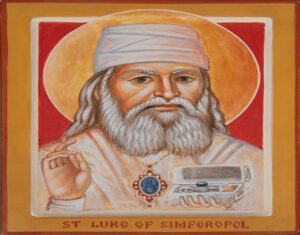
Figure 5: St Luke the surgeon of Simferopol by Aidan Hart.
Luke’s contributions to the field of medicine are extensive, with numerous papers to his name spanning all over his medical career from 1908 to 1956. Those papers concerned many fields of medical science, especially surgery e.g. new surgical methods, surgical treatment of spinal cord injuries and CNS tumors, treatment of pyogenic infections, treatment of osteomyelitis, etc. He even published a book, the “Textbook on Pyogenic Infections” where he precisely describes the surgical treatment of pyogenic infections. This innovative method could assist patients with pus-filled abscesses, localized infections, and infected wounds in surviving in a time when antibiotics were rare and too expensive. In 1946 he was awarded Stalin’s prize for his book. He also has rich writing work in the field of theology with books such as “The Spirit, the Soul and the Body’’, and “Science and Religion” being some of his most significant contributions (17).
Conclusions
In general, the Orthodox Church honors many physicians as saints, calling them the Unmercenary (Anargyroi) saints, i.e., doctors who treated their patients without silver (money). Besides the ones mentioned above, other such saints are Cyrus and John, Ermolaos (teacher of Pantaleon), Mocius, Photius and Anicetus of Nicomedia, Sophia the Physician, Papylos, Alexander of Lugdunum (Lyon), Loukianos, Aimilianos, Episcope Vlasios, Pausikakos, Karpos, Antiochos of Sevasteia, Orestis of Tyana, Aggelis of Chios, Nikostrate the Physician, and more (18).
The Orthodox Church founded by Jesus Christ never rejected medical science. After all, such a thing would be absurd, since the Holy Bible itself, which was studied by the first Christians (the Old Testament), in the book Sophia Sirach, ch. 38, 1-15, orders: “Honor physicians for their services, as the Lord created them and bestowed upon them the gift of healing, which comes from the Most High and is rewarded by the king. The skill of physicians sets them apart, earning them admiration in the presence of the great. Medicines, created by the Lord from the earth, are not to be despised by the wise. Just as water was sweetened by a tree to reveal its power, God granted skill to humans to glorify His marvelous works. Physicians heal and alleviate pain, while pharmacists create mixtures from these remedies. God’s works are boundless, and from Him, health spreads across the earth. When ill, one should pray to the Lord for healing, rectify one’s faults, and cleanse the heart from sin. Offer a sweet-smelling sacrifice and a portion of choice flour, and give physicians their due respect, as they are created by the Lord. Their role may be crucial for recovery, and they pray for success in their work to preserve life. Those who defy their Maker will also defy the physician.’’
References
- Fitzmyer, J. A. (1980). The physician and the evangelist Luke. Theological Studies, 41(3), 435-442.
- Puhalo, Lazar. “The Holy Unmercenary Physicians Zeniada and Philonella, the Friends of Peace”. Lives of the Female Unmercenary Saints. Archived from the original on 2009-10-22. Retrieved 2024-07-15.
- “Hieromartyr Antipas, Bishop of Pergamum and Disciple of Saint John the Theologian”. www.oca.org. Retrieved 2024-07-15
- Lillie, W. J. (2020-09-04). “Saint Hermione, the Daughter of Saint Philip the Deacon”. Pemptousia. Attica. Archived from the original on 2022-03-08. Retrieved 2024-07-15.
- “Martyr Diomedes the Physician of Tarsus, in Cilicia”. oca.org. Orthodox Church in America.
- Til-Pérez G, Tomás-Barberán M, Magri-Ruiz C. Saint Blase, patron saint of otorhinolaryngology. J Laryngol Otol. 2001;115(4):267-269. doi:10.1258/0022215011907334
- **. Basnage Jacques. Histoire de l’Église, depuis Jésus-Christ jusqu’à present. Reinier Leers, Rotterdam, 1669.
- “St Pantaleon the Healer”, Independent Catholic News
- Cosmas and Damian, the Patron Saints of Medicine. Br Med J. 1902;2(2180):1176-1177.
- Friedlaender GE, Friedlaender LK. Saints Cosmas and Damian: Patron Saints of Medicine. Clin Orthop Relat Res. 2016;474(8):1765-1769. doi:10.1007/s11999-016-4929-6
- St Basil the Great the Archbishop of Caesarea, in Cappadocia. OCA – Feasts and Saints.
- Perry, Marvin; Chase, Myrna; Jacob, James R.; Jacob, Margaret C.; Von Laue, Theodore H. (2013). Western Civilization: Ideas, Politics, and Society, Volume I: To 1789 (10th ed.). Wadsworth Cengage Learning. p. 184. ISBN 978-1-111-83170-7. Saint Basil (c. 329 – c. 379), a Greek who was bishop of Caesarea in Cappadocia (eastern Asia Minor), established the rules that became the standard for monasteries in the East.
- Bishop JP. Mind-body unity: Gregory of Nyssa and a surprising fourth-century ce perspective. Perspect Biol Med. 2000;43(4):519-529. doi:10.1353/pbm.2000.0036
- Saint Sampson the Hospitable of Constantinople. www.oca.org. Retrieved 2024-07-15
- *. Yonge CM. History of Christian names. By the author of The heir of Redclyffe. MacMillan and Co, London, 1884.
- Venerable Agapitus the Unmercenary Physician of the Kiev Near Caves, Feast and Saints, Orthodox Church in America www.oca.org. Retrieved 2024-07-15
- Koletsas V, Mavridis I, Pyrgelis ES, Georgiadis G, Vadikolias K, Birbilis TA. Scientific Contributions of Prof. Valentin Felixovich Voyno-Yasenetsky (Saint Luke of Simferopol; 1877-1961) to Surgical Operations of the Nervous System. J Neurol Surg A Cent Eur Neurosurg. Published online July 3, 2024. doi:10.1055/s-0043-1777760
- Schmidt-Voigt J. Ikonen und Medizin. Editiones Roche, Basel, 1994.

